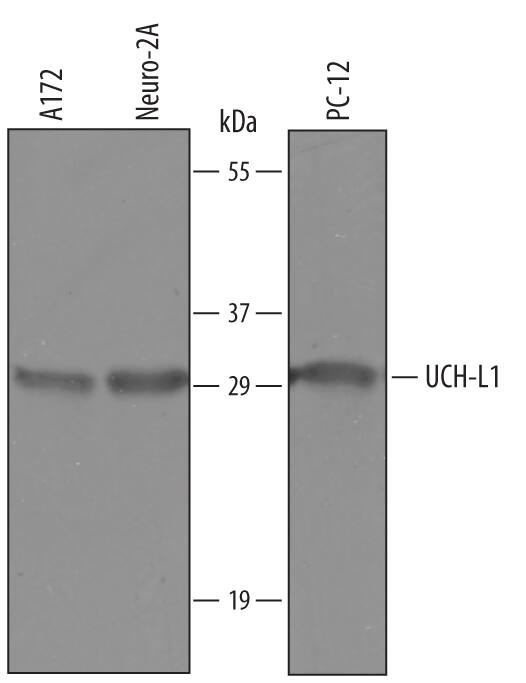Human/Mouse/Rat UCH-L1/PGP9.5 Antibody
R&D Systems, part of Bio-Techne | Catalog # AF6007

Key Product Details
Species Reactivity
Human, Mouse, Rat
Applications
Simple Western, Western Blot
Label
Unconjugated
Antibody Source
Polyclonal Sheep IgG
Product Specifications
Immunogen
E. coli-derived recombinant human UCH-L1/PGP9.5
Gln2-Ala223
Accession # P09936
Gln2-Ala223
Accession # P09936
Specificity
Detects human, mouse, and rat UCH-L1/PGP9.5 in direct ELISAs and Western blots.
Clonality
Polyclonal
Host
Sheep
Isotype
IgG
Scientific Data Images for Human/Mouse/Rat UCH-L1/PGP9.5 Antibody
Detection of Human, Mouse, and Rat UCH-L1/PGP9.5 by Western Blot.
Western blot shows lysates of A172 human glioblastoma cell line, Neuro-2A mouse neuroblastoma cell line, PC-12 rat adrenal pheochromocytoma cell line. PVDF Membrane was probed with 1 µg/mL of Sheep Anti-Human/Mouse/ Rat UCH-L1/PGP9.5 Antigen Affinity-purified Polyclonal Antibody (Catalog # AF6007) followed by HRP-conjugated Anti-Sheep IgG Secondary Antibody (Catalog # HAF016). A specific band was detected for UCH-L1/PGP9.5 at approximately 29 kDa (as indicated). This experiment was conducted under reducing conditions and using Immunoblot Buffer Group 8.Detection of Human and Mouse UCH‑L1 by Simple WesternTM.
Simple Western lane view shows lysates of A172 human glioblastoma cell line and Neuro-2A mouse neuroblastoma cell line, loaded at 0.2 mg/mL. A specific band was detected for UCH-L1/ PGP9.5 at approximately 30 kDa (as indicated) using 10 µg/mL of Sheep Anti-Human/Mouse/Rat UCH-L1/PGP9.5 Antigen Affinity-purified Polyclonal Antibody (Catalog # AF6007) followed by 1:50 dilution of HRP-conjugated Anti-Sheep IgG Secondary Antibody (Catalog # HAF016). This experiment was conducted under reducing conditions and using the 12-230 kDa separation system.Applications for Human/Mouse/Rat UCH-L1/PGP9.5 Antibody
Application
Recommended Usage
Simple Western
10 µg/mL
Sample: A172 human glioblastoma cell line and Neuro‑2A mouse neuroblastoma cell line
Sample: A172 human glioblastoma cell line and Neuro‑2A mouse neuroblastoma cell line
Western Blot
1 µg/mL
Sample: A172 human glioblastoma cell line, Neuro‑2A mouse neuroblastoma cell line, PC‑12 rat adrenal pheochromocytoma cell line
Sample: A172 human glioblastoma cell line, Neuro‑2A mouse neuroblastoma cell line, PC‑12 rat adrenal pheochromocytoma cell line
Formulation, Preparation, and Storage
Purification
Antigen Affinity-purified
Reconstitution
Reconstitute at 0.2 mg/mL in sterile PBS. For liquid material, refer to CoA for concentration.
Formulation
Lyophilized from a 0.2 μm filtered solution in PBS with Trehalose. *Small pack size (SP) is supplied either lyophilized or as a 0.2 µm filtered solution in PBS.
Shipping
Lyophilized product is shipped at ambient temperature. Liquid small pack size (-SP) is shipped with polar packs. Upon receipt, store immediately at the temperature recommended below.
Stability & Storage
Use a manual defrost freezer and avoid repeated freeze-thaw cycles.
- 12 months from date of receipt, -20 to -70 °C as supplied.
- 1 month, 2 to 8 °C under sterile conditions after reconstitution.
- 6 months, -20 to -70 °C under sterile conditions after reconstitution.
Background: UCH-L1/PGP9.5
References
- Wing, S. (2003) Int. J. Biochem. Cell Biol. 35:590.
- Ventii, KH and Wilkinson, KD (2008) Biochem. J. 414:161.
- Gong, B. and Leznik, E. (2007) Drug News Perspect. 20:365.
- Kim, H. et al. (2009) Oncogene 28:117.
- Wang, W. et al. (2008) Int. J. Oncol. 33:1037.
- Yu, J. et al. (2008) Hepatology 48:508.
- Kagara, I. et al. (2008) J. Urol. 180:343.
- Okochi-Takada, E. et al. (2006) Int. J. Cancer 119:1338.
Long Name
Ubiquitin C-terminal Hydrolase L1
Alternate Names
PARK5, PGP9.5, UCHL1
Gene Symbol
UCHL1
UniProt
Additional UCH-L1/PGP9.5 Products
Product Documents for Human/Mouse/Rat UCH-L1/PGP9.5 Antibody
Product Specific Notices for Human/Mouse/Rat UCH-L1/PGP9.5 Antibody
For research use only
